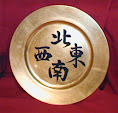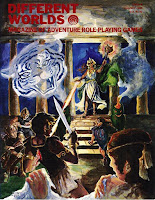The fifth chapter,
Magic, explains how a player character may become a spell-caster, describes
Dragonbane’s three different magical systems/schools, and gives all the in-game details of magic use. There will be many differences here, possibly much more than in the areas of combat and damage, between
Dragonbane and the BRP family of games.
Firstly, Dragonbane is strikingly different from RuneQuest, where famously ‘everyone is a spell caster’, and is somewhat more like the Basic Role-Playing System, where access to magic depends on the PC’s profession.
Getting back to the professions post, remember how each profession had its own unique heroic ability? Well, the mage’s heroic ability is “Magic Talent”, meaning he or she can use magic – actually a single school of magic: each school of magic, of which there are three, has to be learnt separately, i.e., is a discrete Skill, with its skill level. Each given spell belongs to a school of magic and also has to be learnt separately (using up an experience check). The three schools of magic are:
1. Animism
2. Elementalism
3. Mentalism
Note that there is a short collection of ‘general’ spells that can be learnt by practitioners of any school of magic.
There are also ‘magic tricks’, similar to D&D’s cantrips, which are always ready to be cast and do not count against the limit of spells that the PC has memorised (see below).
Animism
Animism is slightly reminiscent of RuneQuest Battle/Spirit Magic, and/or of some of D&D’s druidic spells (like Entangle).
Elementalism
Elementalism harnesses the powers of the elements and provides whizz bang spells, more reminiscent of RuneQuest Rune Magic or of D&D spells.
Mentalism
Mentalism makes use of the mage’s psychic abilities to affect others. It is a mix of D&D psionics and of RuneQuest shamanic abilities or Darkness-/Moon-related Rune Magic.
Learning & Memorising Spells
Spells are not skills but must be learnt separately. Each spell has a rank, a value that has no in-game effect except indicating the minimum skill level (in the relevant school of magic) necessary to learn it. Some spells also have a prerequisite, e.g., you cannot learn Purge if you haven’t learnt Banish before.
A starting mage receives three rank I spells from their school of magic.
The maximum number of spells a PC may hold in their memory, ready to be cast, is approximately equal to INT/2. The PC, however, may learn any number of spells… the player must just state, after each shift rest, which spells the PC has now memorised.
Casting Spells
This will be exceedingly familiar to players of BRP-powered frp games: casting a spell requires the expenditure of the relevant number of WPs and a successful roll against the skill level in the corresponding school of magic. If the roll fails, the WPs are still expended.
Once you have run out of WPs, you may cast spells by ‘sacrificing’ your HPs. This is a great rule, but it may have been more fun to restrict this ability to a certain category of mages (e.g., “blood mages”) rather than make it generally available. This adds to my general impression of the game: the rules are great but they do not manage to impress a particular “flavour” of fantasy in my mind…
Casting a spell is the PC’s action in combat. Period. No complex strike rank calculation, or initiative by spells, ranged weapons, and mêlée combat. As a lazy GM, I love this.
If the skill roll was a critical, the mage may choose one of three effects:
1. Spell damage or range doubled,
2. The spell doesn’t cost any WPs,
3. The mage may immediately cast another spell but with a bane on the roll.
If the skill roll was a fumble, you roll 1D20 and check the magical mishaps table. This is pretty fun, with my favourite ill effect being ‘you vomit a frog the moment you tell a lie’.
Edit− Resisting Offensive Spells
There is no BRP-like Resistance Table in Dragonlance, nor anything like the Mythras opposed rolls.
Spells which affect unwilling living targets all have different ways of being resisted/avoided:
- Spells that create a tangible threat like e.g. Fireball or Lightning Bolt can be dodged or parried as a ranged attack. Others like Pillar (which suddenly creates an earth o stone pillar) can be avoided via a successful Acrobatics roll.
- Some other elemental spells, e.g. Frost or Whirlwind, simply cannot be avoided in any way.
- Some area spells (e.g., Ensnaring Roots) cannot be avoided when first cast, but the target can then break free from the area of effect.
- Most mind-affecting spells, like e.g. Dominate or Sleep, can be resisted via a WIL roll. Some others, however, like Mental Strike, cannot be resisted.
Spells – Some Personal Considerations
The spells are quite diverse, with a good mix of D&D favourites (Fireball, Lightning Bolt, Sleep, Stoneskin) and RuneQuest ones (Countermagic, Detect XXX, Enchantment, Farsee, Fear, Summon/Control XXX Elemental)
My main beef with the spells is that the implied setting is ‘vanilla fantasy’/Old School D&D, yet most of the spells feel ‘magic-user’-ey; there aren’t many ‘clerical’ spells beyond the obvious Cure-like spells, and the Banish/Purge spells (which work like the Turn Undead power of D&D clerics).
Globally, there is a total lack of clerics/priests in the implied setting. I am OK with that – Tunnels & Trolls is one of my favourite frp games, and it doesn’t feature clerics/priests either. But then Trollworld is atheistic, whereas Dragonbane’s implied setting constantly mentions demonic threats (both in the rulebook and in the core set adventures) so I would expect either clerical PCs whose role is to protect the world from demons, or evil NPC priests à la Robert E Howard trying to bring forth demonic dominance into the world.
Also as a diehard RQ fan no gods/deities means no cults.


















